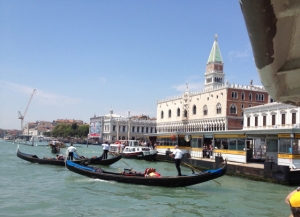Why discuss Navigation in a travel blog?
Several reasons:
- One facet of bike travel is how to reach a new destination;
- Part of navigation is choosing among alternative paths;
- An inevitable aspect of travel is getting lost;
and - In the sense that Interface Design needs to encompass error detection and correction, navigation needs to provide for recovery from becoming lost.
Of course, recovery from becoming lost also requires a discourse on communication styles. (A cursory discussion is all that is possible within the bounds of a mere blog.)
Position and Direction
Navigation implies a goal: travel to a new location. Which assumes some frame of reference that includes both here and there.
The classic presentation of multiple locations is a map: a visual representation of part of the earth’s surface that is easily understood across cultures and languages. An early effort to present the known world was done by Claudius Ptolemy. His map of his home (Alexandria, Egypt) and its environs (circa 150 AD) implemented coordinates (latitude and longitude) that, in slightly modified form, are still part of our reference scheme.
Ptolemy’s interest was based on navigation of both land and sea. But, there are practical differences.
Land vs. Sea
Obviously, there are no landmarks on the open sea. Although the Mariner’s astrolabe (1295), the geometric quadrant (1460), and the sextant (1757) enabled calculation of latitude, it was not until 1737 that the marine chronometer enabled calculations of longitude. The process of land navigation has always been much simpler.
Types of Land Travel
Land travel in the modern era, the time of extensive road / trail networks, has evolved to three modes: maps (static), turn-by-turn directions (static), and GPS (dynamic views / guidance formats).
A sample route from here to there in Paris: (From: 92 Rue du Cherche-Midi, 75006 Paris 06 To: 50 Rue des Bernardins, 75005 Paris 05)
Two formats: map and turn-by-turn:
{click to expand}
Conceptual
Static maps can be conceptual: Munich subway map available as PDF – Munich_trains
GPS
The clear value of a dynamic GPS system is that it shows current location: (e.g. “Where am I?”). That information is redundant, unless one is “lost.”
Lost
In the traditional context of the Bicycle Adventure Club, no one is ever really lost – merely exploring a new set of roads before, eventually, reaching the destination.
But, for some of us, not knowing where we are – and, not knowing clearly how to get to our destination is called: being lost. And, if the destination city has an extraordinarily beautiful cathedral or an artifact-filled museum, being lost may cause a delay that makes exploring the cultural experience of the destination impossible.
And, to return to our discussion of communication styles – some folks prefer maps; some folks prefer cue sheets (the core navigation document of most BAC tours).
|
Distance |
Cumulative |
L/R |
Direction |
Route | Comments |
|
0.0 |
<- |
W |
Main St. | Exit Hotel | |
|
0.2 |
0.2 |
-> |
N |
P’tree Dr. | into center of town… |
|
1.3 |
1.5 |
-> |
E |
Bike Path | …finally safe |
|
5.5 |
7.0 |
<- |
N |
R-16 | Rural road |
Interestingly, many people find both unnecessary: just ask a local person for guidance.
France vs. Italy
Travel in France in 2011 produced a minimal number of “new of road explorations” – we were often in rural areas where there were few decisions (few roads!) – and, the signage was excellent. Of crucial importance, one of us is fluent in French, making requests for guidance from local folks enjoyable and effective.
In Italy in 2012 some real adventures occurred. More complex road systems, poor signage, and a language barrier. (Usually, we can get by with our three functional languages: English, French, and Spanish.) But, in northern rural Italy, the languages are Italian and German.
And, on our worst day, one of the most generous of Italian motorist offered to help. “Oh,” she said, “If you want to reach that city, you are lost.” “I will slowly lead you to the correct road.” She drove slowly, and we pedaled as furiously as we could to keep up. Eventually, she waved and sped up. She was done. She had lead us to the quick route to our destination city. Unfortunately, the quick route was the rural equivalent of an expressway – a death trap for bicycles.
Since we are writing this, we appear to have survived – and, eventually reached our goal: a lovely town in Italy. We eventually found a good map: one that was granular enough to show both our current location and the small roads that we were supposed to be on… But, it was more of an adventure than some of us had desired.
To be fair, there is no perfect navigation system. However, by combining courtesy with a sense of humor, the adventures are not just tolerable; they are a source of understanding about the culture of travel itself.













